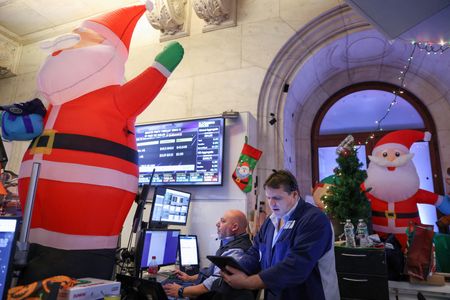A look at the day ahead in U.S. and global markets from Amanda Cooper.
This year, it looks like Santa Claus has no plans to visit Wall Street. The S&P 500 is on course for its third weekly decline and the famed “Santa rally”, where the index stages a run-up in the week leading to Dec. 25, hasn’t materialised.
In fact, as Decembers go, this one is pretty grim. The S&P is on track for a 6.3% decline this month, its fourth-worst December on record, with the top spot going to December 1931, when it fell 14.53%, followed by 2018, with a 9.4% drop, and 1930, when it lost 7.4%.
Crunching the numbers, the S&P 500 has rallied in the week leading up to Dec. 25 in 65 out of the last 90 years – scant consolation to anyone nursing losses on their portfolio right now.
But that begs the question: Do year-end rallies last?
The S&P 500’s Santa rally has continued beyond Christmas and into at least the first week in January in 53 out of the last 90 years, according to Reuters calculations.
From there, the S&P’s New Year winning streaks become fewer and further between. The index rallied straight into the third week of January in just 22 of the 90 years.
On average, since 1932, the S&P 500 has returned some 0.4% in any given Santa rally week. That might not seem especially exciting, but historically the index has returned an average of 0.16% every week of the year in the last 90 years, so it’s not to be dismissed either.
The biggest Santa rally was a whopping 5% weekly gain in 1991, right after the Federal Reserve, under Alan Greenspan, delivered a three-quarter point interest rate cut – the most in a month since late 1984 – as it battled a sluggish economy and high unemployment.
The worst pre-Christmas week was in 1957, bang in the middle of what was known as the “Eisenhower recession”. The index found absolutely no holiday cheer and fell 3.1% that week. Back then, the Fed was raising rates to bring down inflation.
So for anyone that feels they’ve been very good this year and is disappointed they didn’t get an S&P rally in their stocking this week, there could still be decent a chance of a bounce-back come January.
Key developments that should provide more direction to U.S. markets later on Friday:
* U.S. University of Michigan December final sentiment
* U.S. November new home sales
* U.S. November durable goods orders
* U.S. November personal consumption and expenditure
(Reporting by Amanda Cooper; Editing by Mark Potter)

